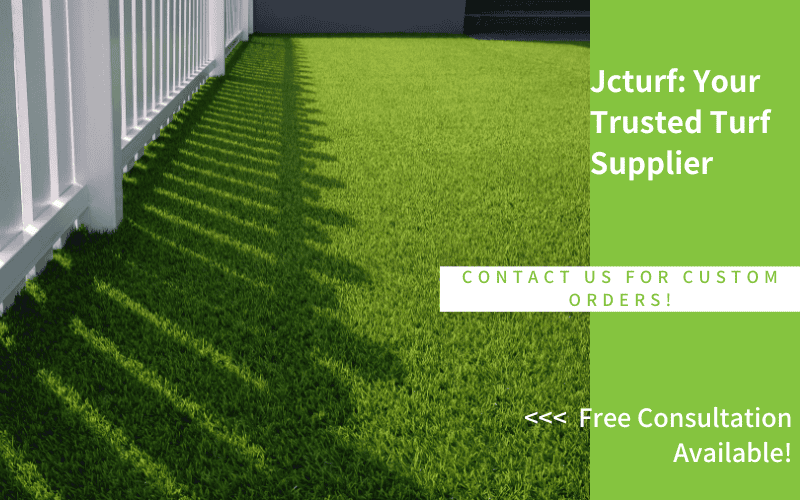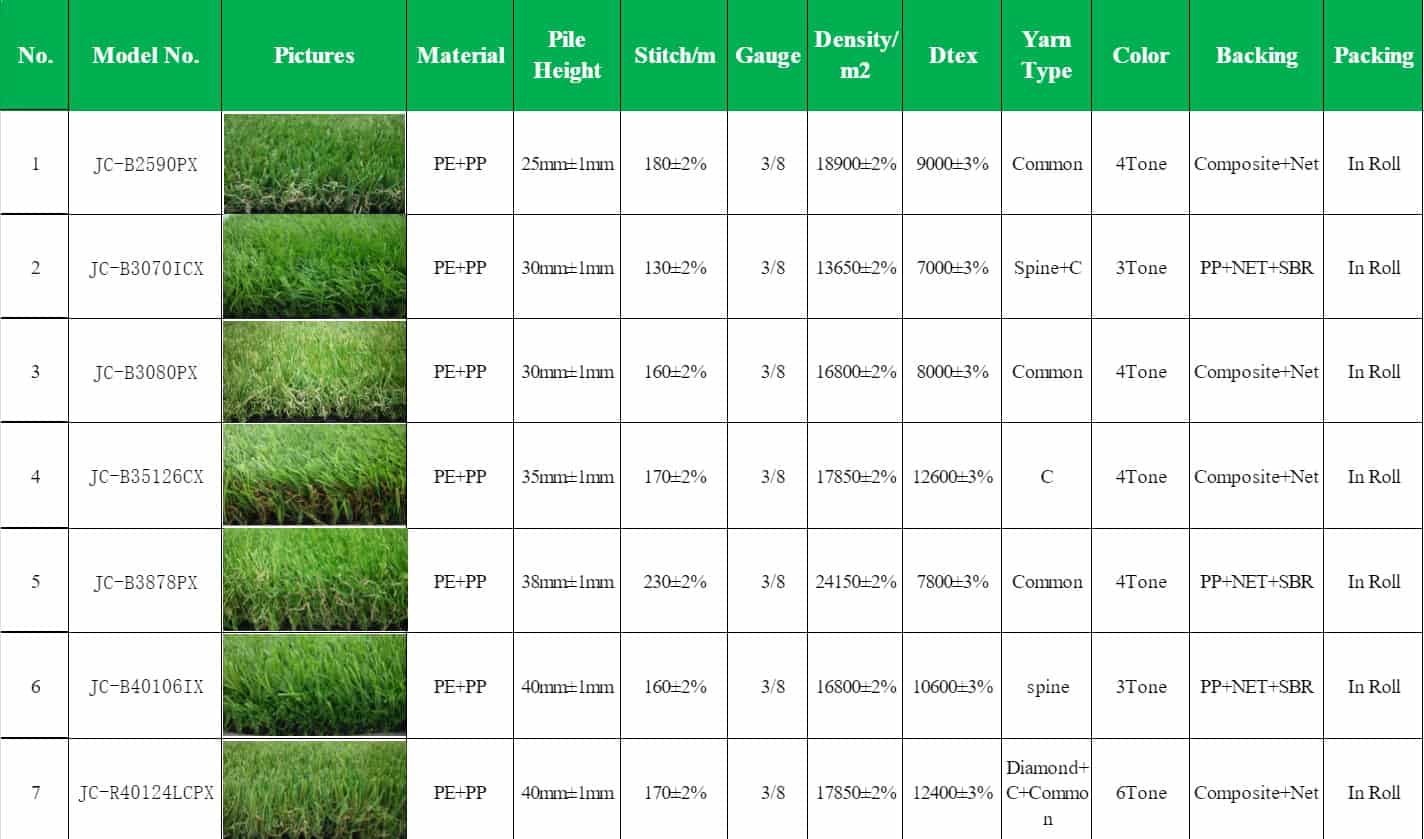Finding the best artificial grass depends entirely on where and how you’ll use it. A soft, well-draining lawn is ideal for backyards. Pet zones need odor control and tough fibers. Kids’ play areas require safety padding. Hot climates demand heat-resistant turf, and golf greens need precision. Poolside? You’ll want something that drains fast and stays slip-resistant.
In this guide, we’ll help you find the best artificial grass based on your space and usage. You’ll discover which turf types work best for backyard landscapes, pet areas, playgrounds, hot climates, putting greens, and poolside zones. We’ll also walk you through how to choose the best artificial grass—from drainage and fiber type to safety and material certifications—so you can make a confident, informed decision.
What Is the Best Artificial Grass for Backyard Landscaping
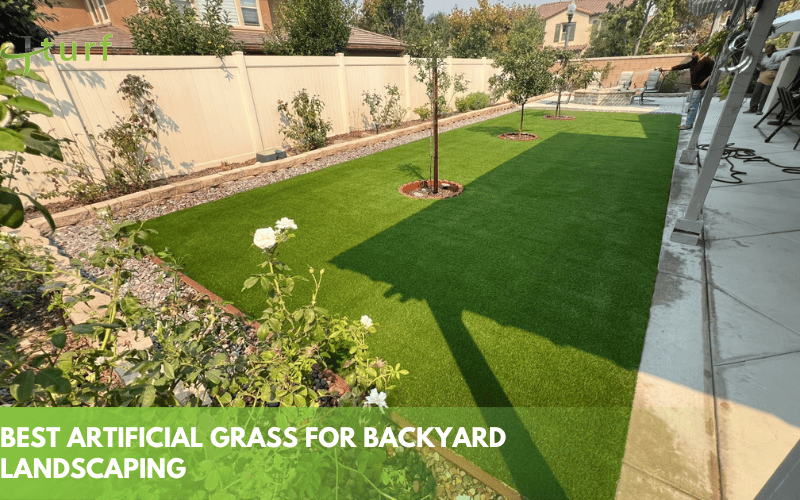
The best artificial grass for backyard use is one that balances softness, durability, and drainage. Look for a 30–40mm pile height to get a lush feel that won’t flatten easily, and make sure the turf has a high stitch rate for better strength.
A quality drainage system is also essential, especially if your backyard sees a lot of rain or irrigation. The turf’s backing should allow water to flow through quickly to avoid puddling.
For realistic appearance, choose grass with a color mix—usually a blend of green and brown fibers. This mimics natural grass more effectively than a bright green-only look.
Finally, check the technical specs. The right turf for your backyard isn’t necessarily the thickest or the most expensive. It’s the one that fits your daily use and local weather.
What Is the Best Artificial Grass for Dogs and Pet Areas?
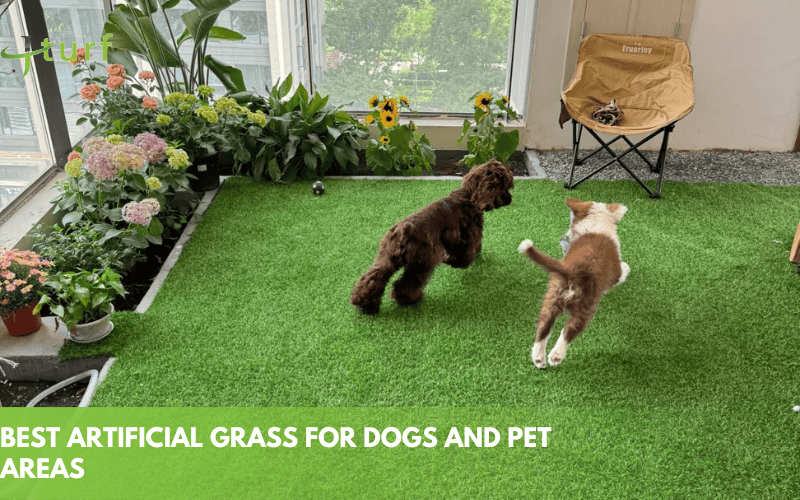
The best artificial grass for dogs is one that drains fast, resists odors, and stays safe under paws. Look for turf with excellent drainage, non-toxic materials, and a dense, durable fiber structure that can stand up to claws and repeated use.
When pets urinate on grass, the liquid must drain quickly through the backing. Choose turf with a permeable base and avoid options with latex backings that may trap moisture. A drainage rate of 60 liters/min/m² or more is ideal for pet zones.
Odor control is another key. Some pet-friendly products include antimicrobial coatings or are compatible with odor-neutralizing infills. If smell is a concern, check what infill your system will use.
For durability, PE-based grass with a tight stitch rate works well. It won’t tear easily and still feels soft enough for animals to lie on. Avoid overly soft or fluffy options—they tend to mat down and trap debris over time.
Pet-friendly turf doesn’t have to look boring. Many premium products balance performance and appearance, giving you a clean, realistic lawn your dog will love—and that you’ll enjoy too.
What Is the Best Artificial Grass for Children’s Play Areas?
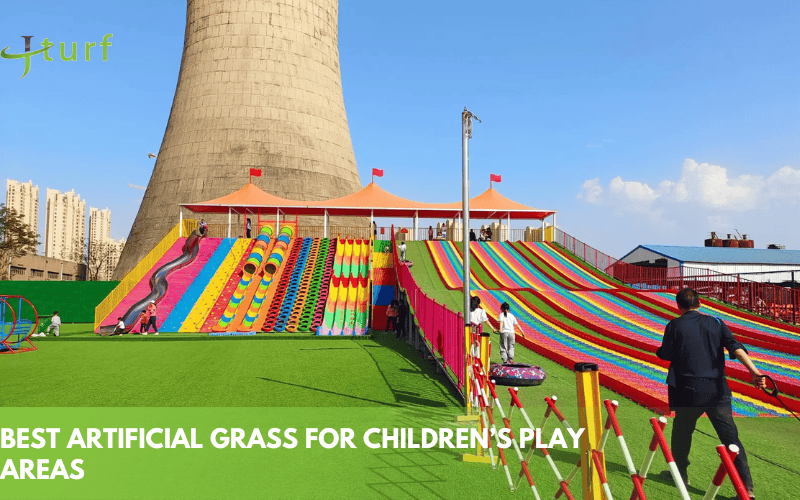
The best artificial grass for children’s play areas is soft, safe, and designed to reduce the risk of injury. It should include a shock-absorbing base layer, use non-toxic materials, and offer a surface that stays cool and comfortable underfoot.
For safety, check whether the turf system is rated for critical fall height. This rating shows how much impact the surface can absorb during a fall. A quality play-area installation often includes a foam shock pad underneath the grass to meet safety standards—especially in schools and playgrounds.
The turf fibers themselves should be short to medium height (25–35mm) and densely stitched to avoid matting. Softness matters, but so does structure. If the turf is too loose or fluffy, it can trap debris and wear down fast.
Heat retention is another concern. Choose turf made with heat-reducing yarns or consider lighter colors to keep the surface cooler during summer play.
Above all, make sure the product is certified free of harmful chemicals. Most reputable suppliers can provide safety certifications that confirm the turf is safe for kids to touch and play on every day.
What Is the Best Artificial Grass for Hot Climates?
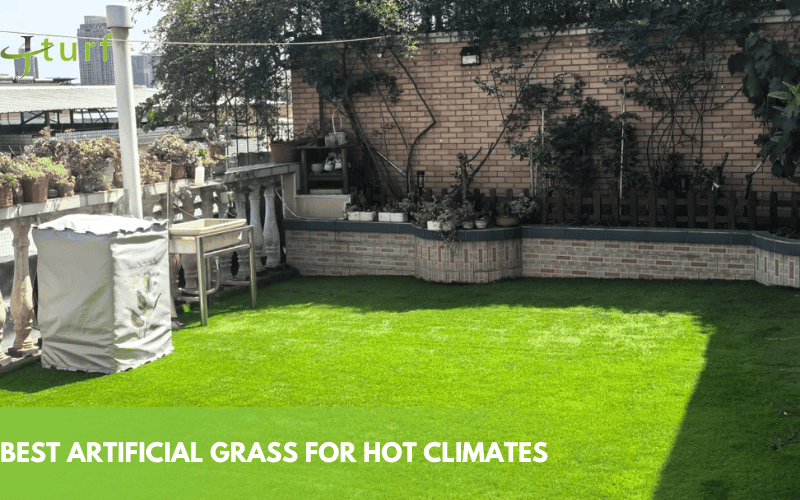
The best artificial grass for hot climates is built to handle direct sunlight, stay cooler underfoot, and resist fading or damage from heat. You need turf made with UV-stabilized fibers, heat-resistant materials, and an open drainage system to help lower surface temperature.
Some advanced products use heat-reflective yarns that don’t absorb as much sunlight, which helps keep the surface cooler during the hottest parts of the day. Lighter-colored grass fibers can also reduce heat buildup compared to deep green or dark infill types.
Backing materials matter too. Choose a turf with a perforated base for better airflow and water movement, which helps dissipate heat. Avoid latex-backed products in hot zones—they can retain heat and degrade over time.
If you’re using infill, consider options like silica sand or specialized cooling infill, which can lower surface temperature by several degrees compared to traditional rubber infill.
Before you choose, ask your supplier for UV exposure test results or case studies in similar climates. What performs well in mild weather may not last under intense sun.
What Is the Best Artificial Grass for Putting Greens?
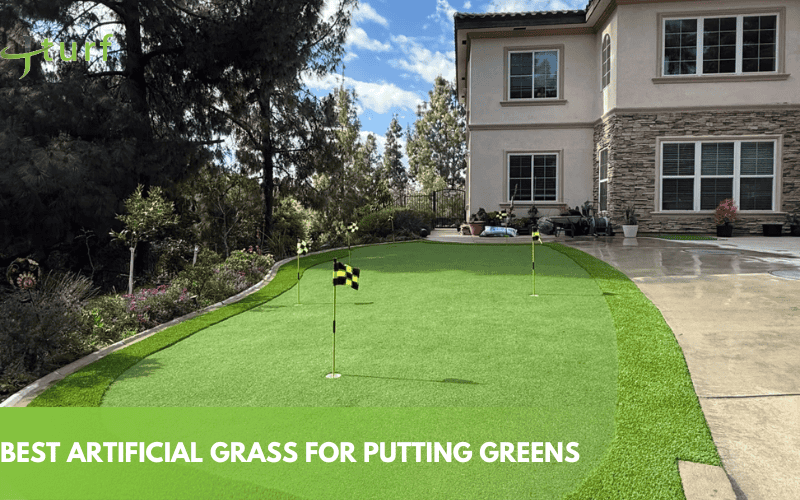
The best artificial grass for putting greens is short, dense, and engineered for consistent ball roll. It’s completely different from regular landscape turf—you need precision, not softness.
Look for turf with a pile height between 10–15mm, often made of nylon or polypropylene fibers for extra stiffness and control. A smooth, tightly stitched surface ensures the ball rolls true, without bouncing or slowing unexpectedly.
Unlike decorative turf, putting green grass doesn’t need to feel soft—it needs to be flat and fast. That’s why the base is just as important as the turf. A compacted, laser-leveled sub-base will keep the surface smooth over time.
If you want a true golf-like feel, some systems include a separate fringe zone with longer fibers around the edge. This helps simulate real play and adds visual appeal.
Remember: even the best turf won’t perform well without proper installation. For golf applications, precision matters more than pile height alone.
What Is the Best Artificial Grass Around Swimming Pools?
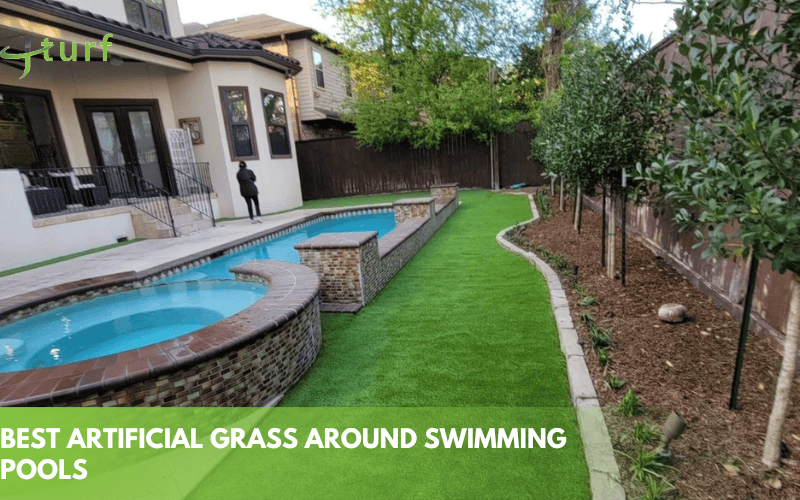
The best artificial grass around swimming pools is quick-draining, slip-resistant, and built to handle water, heat, and chemicals. It should feel comfortable under bare feet—even on hot days—and stay safe when wet.
Start with permeable backing. Pool areas often get soaked, and water needs to flow through the turf—not sit on the surface. Look for a system with full drainage perforations to prevent puddling.
Next, think safety. Choose turf with a non-slip texture, especially if kids will be running around. The surface should remain stable even when wet, and the infill should not float or wash away.
Pool chemicals like chlorine can degrade some turf materials. Make sure your artificial grass is made from UV-stabilized, chlorine-resistant fibers that won’t fade or break down over time.
To manage heat, lighter yarn colors and heat-reflective materials help reduce surface temperature. Some homeowners also install shade elements or misting systems in high-exposure areas.
Finally, consider the edge treatment. Grass near pools often borders stone or tile, so a clean transition is key. Talk to your installer about how to secure seams and edges to keep everything tight and safe.
How to Choose the Best Artificial Grass
Choosing the best artificial grass isn’t just about how soft it feels or how green it looks. To get turf that performs well over time, you need to focus on four key factors: durability, realism, drainage, and safety. These are what truly define turf quality—regardless of price or promises. Below, we’ll break them down so you can make a smart, informed choice.
Durability and Traffic Resistance
If your turf will handle pets, kids, or frequent use, durability is the top priority. Look for fibers made from polyethylene or nylon—both are known for strength and resilience. Check the face weight (oz/sq yd)—a higher number usually means denser, longer-lasting turf. A durable product should also have a strong tuft bind to keep the fibers in place under pressure. Lastly, if your area gets strong sun, make sure the turf is UV stabilized to prevent fading and brittleness.
Ask your supplier for the face weight, tuft bind strength, and UV resistance rating to ensure long-term durability.
Realistic Appearance and Texture
Great artificial grass should look like the real thing—even up close. You’ll want a pile height of 30–40mm for lush lawns, and a natural color blend with some brown or olive thatch, not just flat green. Density matters too: tightly stitched blades stand upright better and feel fuller underfoot. If the turf is too soft or too sparse, it will flatten quickly and lose that fresh-cut look.
Compare multiple samples under sunlight and foot pressure to find the most realistic and resilient texture.
Drainage and Backing Quality
Good drainage is essential—especially for pets, pools, or rainy areas. Check that the turf has a perforated backing or a fully permeable base that allows water to flow through quickly. A rate of 50–60 liters/minute/m² is a good benchmark. Backing materials also impact longevity; choose a non-latex, dual-layer system for better strength and water resistance. Poor drainage leads to puddles, odor, and mold—avoid it at all costs.
Flip the turf over and ask for the drainage rate—make sure it meets your climate or usage needs.
Safety, Materials & Certifications
If kids or pets will be using the turf, safety isn’t optional. Choose turf made from non-toxic materials, and ask for documentation like lead-free or heavy metal-free certifications. Some products come with antimicrobial additives to prevent bacteria and odors—especially useful in pet zones or playgrounds. A quality supplier will always be transparent with lab reports or safety data. If they’re not, that’s a red flag.
Request safety certifications and antimicrobial details before making your final choice.
Before you decide, bring a few turf samples home. Test them underfoot, under sunlight, and with real use in mind—what feels right under your feet will often be the best match for your space.
Ready to Find the Best Artificial Grass for Landscaping, Sports, Pets & Putting Greens?
There’s no one-size-fits-all turf—but there is always the right one for you.
At Jcturf, we specialize in the design, R&D, manufacturing, and export of high-quality artificial grass. From fiber innovation to after-sales service, we support every step of your project with technical expertise and reliable products.
Whether you need lush landscape turf, durable sports turf, pet-friendly turf, or precision-made putting greens, we can help you choose the best artificial grass based on your usage, budget, and environment.
Contact our team to get expert recommendations, request a product catalog, or start a project conversation.
We don’t just sell turf—we help you find the right one.

